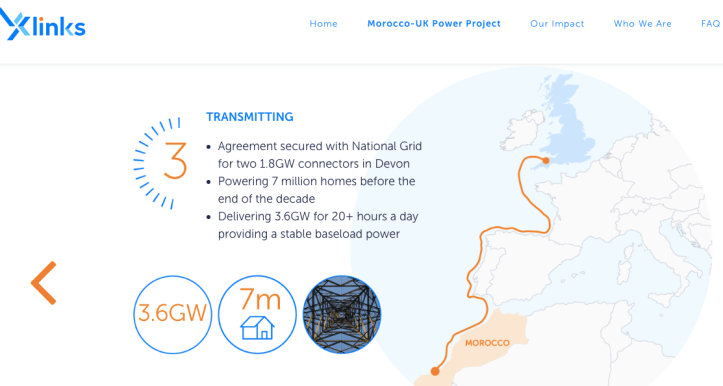–UK carbon prices surge
–European power futures can now be traded 10 years ahead
By Mathew Carr
Sept. 27-28, 2021 — (LONDON) This plan to send power from Morocco to the U.K. shows how opportunities for trading carbon — collaborating between countries to meet the Paris carbon budget — are becoming abundant.
Here is the proposal:

Free-flowing electricity around the world — linked to well-managed power markets that are deep and price carbon — will dramatically cut the need for fossil fuels.
Let’s unpack this a bit and join a few dots.
U.K. carbon prices surged Monday. I’m not sure they are factoring in this Morocco deal (stay tuned). [And importantly, from Sept. 27 onwards, exchange group EEX will extend the number of tradable yearly maturities for German, Italian and Spanish Power Futures from the current six to ten calendar years. This enhancement will enable customers to hedge their price exposure up to 10 years in advance which will further promote the integration of renewable energy into the power market. This is known as an elongated power curve.]
U.K. Carbon Futures Monday (they are even higher today at 75 quid).

British spot power prices (pounds vs euros) are already pricey

There are plenty of other explanations for surging carbon and power prices.
The Morocco deal is a sort-of carbon trade, as dirty countries cut emissions and import clean power from lower-carbon countries.
Instead of building new coal and natural gas plants, solar farms can not only provide power to the emerging country (for example) and saving it building coal plants, but allow for more dramatic cuts in countries most to blame for the climate crisis, who will largely pay for / finance them. That’s the trade.
The world-wide-web of power cables will have to run east-west and west-east as well, so solar power on one side of the world can electrify the dark side. Windy areas supply the windless.
See these comments from Total SA, the French energy group.

I asked on LinkedIn: Harrison … Do you believe there’ll be a World Wide Web of power cables soonish sir? This would allow solar power to be always on because the sunny side can send electricity to the earth’s dark side? Wind power too….from windy to windless ?
Waugh’s response:
“The depths and length of cable are telephone numbers but it’s doable from a technical perspective.’
“This is largely due to the advances in HVDC technology and the ability to transmit long distance without large losses (believe the project mentioned above (a cable plan to send power from northern Australia to Singapore) was around 10% loss over that entire length).
However – two factors have to be thrown into the formula:
1. Cost of fabrication and installation of cable / km
2. Energy losses / km
Those two combined bring other (less efficient) modes of energy transit into play such as hydrogen / ammonia. You can stomach a less efficient energy conversation (electricity – X – electricity) if it means avoiding $$$ in cable cost.
I recently saw a ‘battery ship’ concept from Japan that would charge up at the windfarm location from a stationary battery and shuttle the power back to shore, thus avoiding the huge depths and lengths of cabling needed.
Expansive and fascinating to say the least but I do think the Aurora (the cable ship) will be a busy asset…“
There are plenty of other ways of sending power. Check out the post in the caption above — and the comments on it –as well as link below.
For me, these projects show cross-border “carbon trading” (without carbon credits in this case I think, maybe) is now getting truly innovative:
See this cool bit, for instance: Xlinks will be a net contributor to the Exchequer (UK Treasury), if the project utilises the UK Government’s Contracts for Difference (CfD) mechanism. Xlinks will not require Government subsidy or finance – and will deliver energy at £48/MWh CfD, pricing it below BEIS’s central forecast for energy prices. This means it will generate savings for consumers. Contracts for difference pay out if a project operates in an environment where either power or carbon market prices are lower than expected when the contract is struck. Guaranteeing protection against lower carbon or power prices boosts the chance the project will get done.
From EEX

The www of power is being pushed too by China and India.

(Updates with context, U.K. carbon surge, power curve extends on EEX; more to come)
